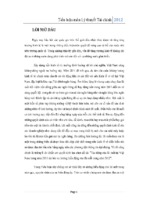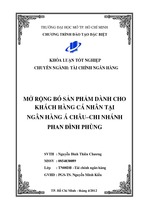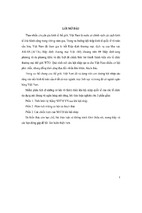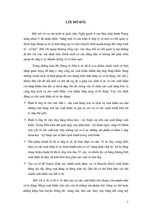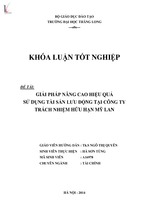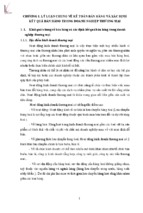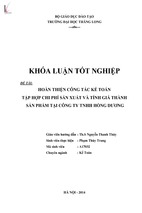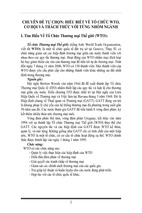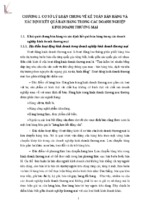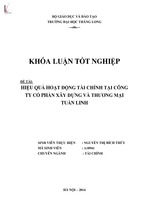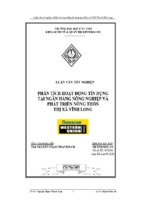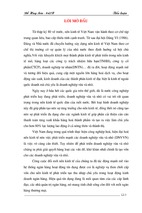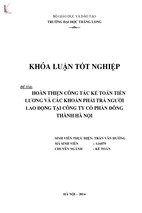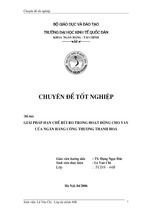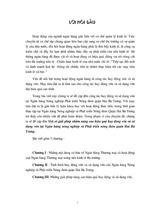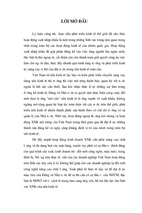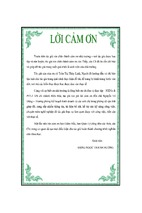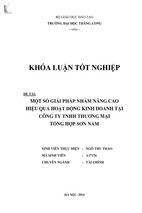MAJOR THESIS
Supervisor: Phạm Kim Ngọc,M.A
Table of Contents
Preface.......................................................................................................................... 3
Chapter I: Overview of audit documentation and working papers in auditing
financial statements.....................................................................................................4
1
The concept of financial audit..............................................................................4
1.1
Nature of audit..................................................................................................4
1.1.1 The demand for reliable information.............................................................4
1.1.2 Reducing information risk and the rise of audit..............................................5
1.2 Audit Definition...................................................................................................5
2
Overview of audit documentation and working papers in auditing financial
statements...................................................................................................................... 6
2.1
Audit documentation........................................................................................6
2.1.1 Audit documentation definition.....................................................................6
2.1.2 Types of Audit documentations....................................................................7
2.1.3 The role and meaning of audit documentation...............................................8
2.2 Working papers....................................................................................................8
2.2.1 Working papers definition..............................................................................8
2.2.1.1. What are working papers:.......................................................................8
2.2.1.2 Reason in preparing working papers:.......................................................9
2.2.2 Content of Audit working papers...............................................................11
2.2.3 Importance of working papers......................................................................14
2.2.3.1 Importance of Working papers.............................................................15
2.2.4 Review of working paper.............................................................................15
2.2.4.1 Review of working paper.......................................................................15
2.2.4.2 Checking the working papers:................................................................16
2.2.4.3 Confidentiality of working papers..........................................................16
Chapter 2: Current situations of designing audit procedures in auditing the
financial statements of listed companies implemented by AAC Auditing and
Accounting Co., Ltd...................................................................................................17
1
Overview of AAC Auditing and Accounting Co., Ltd.......................................17
Student: Nguyễn Quang Trung
Page 1
MAJOR THESIS
1.1
Supervisor: Phạm Kim Ngọc,M.A
Establishment and development history......................................................17
Organizational Structure of AAC..........................................................................19
2. Reality the organization of working papers system at AAC Company.................21
2.1 An overview about the reality on the AAC’s working papers.........................21
2.1.1 Regulations on working papers in AAC....................................................21
2.1.1.1. Form of working papers........................................................................21
2.1.1.2. The general form of standard working papers at the company AAC....21
2.1.1.3. Symbol used..........................................................................................22
2.1.1.4 Typing reference on paper work...........................................................25
2.1.1.5. Linking working paper..........................................................................26
2.1.1.6. Principle in review working paper of AAC...........................................26
2.2.1 Sets of working paper account cash and equivalen cash...............................29
Chapter III. SOME REMARKS AND PROPOSALS FOR ESTABLISHING
WORKING PAPERS LIBRARY OF COMPANY ACCOUNTING AND AUDIT
AAC............................................................................................................................ 32
3.1 Advantages and disadvantages of current working paper...................................32
3.1.1 Advantages.................................................................................................32
3.1.2 Disadvantages.............................................................................................33
3.2 Recommendations in order to improve working papers libraries AAC Company
.................................................................................................................................. 33
3.2.1 Completing the design unfinished procedure in the paper work.................34
3.2.1.1 Account cash an equivalent cash..........................................................34
3.2.1.2 Account receivables...............................................................................34
3.2.1.3 Account payable...................................................................................35
*Adjusting the Balance per Bank.......................................................................37
*Adjusting the Balance per Books.....................................................................38
Conclusion.................................................................................................................. 50
REFERENCES............................................................................................................50
Student: Nguyễn Quang Trung
Page 2
MAJOR THESIS
Supervisor: Phạm Kim Ngọc,M.A
Preface
Today, audit working paper is not the strange terminology with the economists
because of their important role for the audit. Building is a complete working paper
systems which can be used for any company is a huge target for any public audit
Company. As the fact that, in 2014, AAC Audit Company has a changing in working
paper system for the new one, I think I should do a small development program one
hand learning about the importance of the audit working papers system and inn the
other hand contribute a small part of completing the AAC working system. With the
limited content, I will divide my article into 3 chapters
+CHAPTER 1: Overview of audit documentation and working papers in
auditing financial statements
+CHAPTER 2: Current situations of designing audit procedures in
auditing the financial statements of listed companies implemented by
AAC Auditing and Accounting Co., Ltd
+Chapter 3:+ SOME REMARKS AND PROPOSALS FOR
ESTABLISHING WORKING PAPERS LIBRARY OF COMPANY
ACCOUNTING AND AUDIT AAC
Student: Nguyễn Quang Trung
Page 3
MAJOR THESIS
Supervisor: Phạm Kim Ngọc,M.A
Chapter I: Overview of audit documentation and working
papers in auditing financial statements
1
The concept of financial audit.
1.1
Nature of audit
1.1.1 The demand for reliable information
As society becomes more complex, decision makers are more likely to face
with the information risk which lead the investors may make wrong decisions for their
investments. After scandal of Sabena Oxley, information risk becomes an emerging
issue which is concerned by all economists in the world.
According to “Audit and assurance services”, the information risk is: the
probability that the information circulated by a company will be false or misleading.
Client management has an incentive to make the business appear better than it actually
may be. This can create a conflict of interest between client management and
investors.
There are several reasons for information risk: remoteness of information,
biases and motives of the provider, voluminous data, and the existence of complex
exchange transactions.
Remoteness of Information: In a global economy, it is nearly impossible for a
decision maker to have much knowledge about the organization with which they do
business because decisions makers are not trained to collect, compile, and summarize
the key operating information themselves. They need to rely on the others which can
cause to intentionally or unintentionally misstated increases.
Biases and Motives of the Provider: If information is provided by someone
whose goals are inconsistent with those of the decision maker, the information may be
biased in favor of the provider.
Voluminous Data: organizations become larger accompanied by the volume of
their exchange transactions. This increases the likelihood that improperly recorded
information is included in the records perhaps hidden in a large amount of other
information. If many minor misstatements remain undiscovered, the combined total
can be significant.
Complex Exchange Transactions: In the past few decades, exchange
transactions between organizations have become increasingly complex and therefore
more difficult to record properly. For example, the correct accounting treatment of the
acquisition of one entity by another poses relatively difficult accounting problems.
Other examples include properly combining and disclosing the results of operations of
subsidiaries in different industries and properly disclosing derivative financial
instruments.
Student: Nguyễn Quang Trung
Page 4
MAJOR THESIS
Supervisor: Phạm Kim Ngọc,M.A
1.1.2 Reducing information risk and the rise of audit.
After comparing costs and benefits, business managers and financial statement
users may conclude that the best way to deal with information risk is simply to have it
remain reasonably high. A small company may find it less expensive to pay higher
interest costs than to increase the costs of reducing information risk.
For larger businesses, it is usually practical to incur costs to reduce information
risk. There are three main ways to do so.
User Verifies Information: The user may go to the business premises to
examine records and obtain information about the reliability of the statements.
Normally, this is impractical because of cost. In addition, it is economically inefficient
for all users to verify the information individually.
There are some users can perform their own verification such as the tax
department do this to reflect the actual tax due the government or the company use
auditors to verify and evaluate the information of potential child company in the
business acquisitions purpose.
User Shares Information Risk with Management: There is considerable
legal precedent indicating that management is responsible for providing reliable
information to users. If users rely on inaccurate financial statements and as a result
incur a financial loss, they may have a basis for a lawsuit against management. A
difficulty with sharing information risk with management is that users may not be able
to collect on losses. If a company is unable to repay a loan because of bankruptcy, it is
unlikely that management will have sufficient funds to repay users.
Audited Financial Statements Are Provided: The most common way for
users to obtain reliable information is to have an independent audit. Typically,
management of a private company or the audit committee for a public company
engages the auditor to provide assurances to users that the financial statements are
reliable.
Decision makers can then use the audited information on the assumption that it
is reasonably complete, accurate, and unbiased. The auditor work is valuable because
of the auditor’s independence from the client and knowledge of financial statement
reporting matters, and their checking expertise. This way is the most common way to
reduce the information risk and that is economics demand for auditing.
1.2 Audit Definition
According to auditing and assurance services fifth edition: Auditing is a
systematic process of objectively obtaining and evaluating evidence regarding
assertions about economic actions and events to ascertain the degree of
correspondence between the assertions and established criteria and communicating the
results to interested users.
Financial audit is a typical activity of the audit, with the specific objective is "to
express an opinion confirming that the financial statements have been prepared on the
Student: Nguyễn Quang Trung
Page 5
MAJOR THESIS
Supervisor: Phạm Kim Ngọc,M.A
basis of standards and current accounting regulations (or be acceptance), with related
legal compliance, there give a true and fair view, in all material respects or not
Audit Assertions are the implicit or explicit claims and representations made by
the management responsible for the preparation of financial statements regarding the
appropriateness of the various elements of financial statements and disclosures. The
financial audit assertions are about the trueness and fairness of the financial statement
(include the footnotes statement)
The established criteria is the common set of accounting principles, standards
and procedures that companies use to compile their financial statements. GAAP are a
combination of authoritative standards (set by policy boards) and simply the
commonly accepted ways of recording and reporting accounting information.
An external user is a person outside of an organization who does not directly
run its operations and uses financial or accounting information about that company to
make decisions. In other words, it’s someone who doesn’t manage or work for a
company but uses its financial information. The common external user is investors,
creditors
and
banks.
The overview of the finicinl stntemeit nudit
2
Overview of audit documentation and working papers in
auditing financial statements
2.1
Audit documentation
2.1.1 Audit documentation definition
Student: Nguyễn Quang Trung
Page 6
MAJOR THESIS
Supervisor: Phạm Kim Ngọc,M.A
With any audits, Evidence is obtained by the auditor to determine whether the
information being audited is stated in accordance with the established criteria. To
satisfy the purpose of the audit, auditors must obtain a sufficient quality and volume of
evidence. Auditors must determine the types and amount of evidence necessary and
evaluate whether the information corresponds to the established criteria. The auditors
need to storage this evidence and all the work they had done in the audit
documentation for audit purpose.
According to the Auditing Standards Number 230 Issued under Decision No
120/1999 / QD-BTC of September 27, 1999 of the Ministry of Finance stated: Audit
records are documents auditors established, collected, sorted, used and storage stored
in a certain order as evidence for one specific audit. Documents in the Audit
documentation is shown on paper, on film, photographs, informatics media or any
other storage media in accordance with current law
2.1.2 Types of Audit documentations
According to VSA 230, the audit documentation divided should be prepared
and arranged into: permanent audit documentation and current audit documentation
2.1.2.1. Permanent Audit documentation
VSA 230 defines general audit documentation as follows: Permanent audit files
is record contains general information about the client involves two or more audits
during the financial years of a client.
This files stored documents, schedules and other historical or continuous
information needed for many years. This profile provides a suitable source of
information about the client, service of current and future audits if contracts continue.
Continually updated information is also a problem should be noted with this
file. Permanent audit documentation is the useful tool for the audit. In some specific
case, Auditors only focus on complete the current audit documentation and they don’t
review and update the information of permanent audit files. This may lead to the
reducing of quality of this information because the information in it has become
outdated and often not usable anymore, leading to influence audit quality.
Thus, the examination and update documents in permanent audit files on a
regular basis are essential. Auditors should add new information and adjust old
information when client’s Company information has changed and they must specify
the changes in this file.
2.1.2.2 Curret audit documentation
VSA 230 has defined Current audit file as follows: "current audit
documentation is the file contain customer information relates only to audits of
financial year”
Annual audit records include documents provided by the customer, such as
financial documents, accounting, taxes, of state agencies and superiors concerning the
financial year; The minutes confirmed by stakeholders sent to. Besides, it include the
Student: Nguyễn Quang Trung
Page 7
MAJOR THESIS
Supervisor: Phạm Kim Ngọc,M.A
documents of auditor; Notes on content, program and scope of the audit procedures
performed and the results obtained; The audit report, management letter and other
reports; The correspondence with other auditors, experts and other stakeholders;…
2.1.3 The role and meaning of audit documentation
Audit documentation has collected all information relevant to their audit clients
to serve their audit work as:
+ Storing the evidence collected by performed auditor as basis for an opinion of
auditors:
The information about the customer as well as the object audit fully updated
and supplemented continuously throughout the audit process to ensure adequate basis
for forming auditors audit opinion. This evidence obtained ensure the opinions of
auditor are base on the reliable, quality assurance of audit
+ Help for planning and performing the audit.
Normally, an audit is taking place by two or three auditors above in the certain
time period. They need audit plan to divide work and forming structure of the entitle
audit to conduct the audit efficiently. To get a appropriate plan for the current year, the
auditor must consult the information about the client (with the new client) and refer the
previous audit documentation (with the old one).
+ Help for inspection, review and evaluate the quality of the audit:
All documents, information and evidence collected are storing in the audit
documentation. Chief audit team checked the working paper and request explanations
of subordinates before giving up a higher level for approval. This is the basis for the
inspectors to understand the entire contents of the audit as well as oversight the work
of subordinate thus it also increases the quality of audit.
+ Help for the treatment of arising after the audit:
The occurrence of conflicts and litigation, as well as quality test of Association
practice and the Ministry of Finance is inevitable. Then audit documentation is
important legal evidence help auditors solve the problems that arise after the audit. It
can prove that audit was planned well, fully supervised, progress operating in
accordance with auditing standards. With audit evidence collected valuable, complete,
timely and audit reports were correct evaluation of audit results, audit file would
minimize audit risk may occur. On the other hand the audit files also the information
that helpful for future audits.
2.2 Working papers
2.2.1 Working papers definition
2.2.1.1. What are working papers:
“Working papers “are the written record of the basis for the auditor's
conclusions that provides the support for the auditor's representations, whether those
representations are contained in the auditor's report or otherwise. Audit working papers
also facilitates the planning, performance, and supervision of the engagement, and is
Student: Nguyễn Quang Trung
Page 8
MAJOR THESIS
Supervisor: Phạm Kim Ngọc,M.A
the basis for the review of the quality of the work because it provides the reviewer
with written documentation of the evidence supporting the auditor's significant
conclusions. Among other things, working papers include records of the planning and
performance of the work, the procedures performed, evidence obtained, and
conclusions reached by the auditor.
It may be in the form of data stored on the paper, film, electronic media, or
other media. They can also be used in court e.g. in case of negligent audit.
Working papers are reviewed by members of the engagement team performing
the work and might be reviewed by others for different purposes. Reviewers might
include, for example:
+ Auditors who are new to an engagement and review the prior year's
documentation to understand the work performed as an aid in planning and performing
the current engagement.
+ Supervisory personnel who review documentation prepared by other
members of the engagement team.
+ Engagement supervisors and engagement quality reviewers who review
documentation to understand how the engagement team reached significant
conclusions and whether there is adequate evidential support for those conclusions.
+A successor auditor who reviews a predecessor auditor's audit documentation.
+ Internal and external inspection teams that review documentation to assess
audit quality and compliance with auditing and related professional practice standards;
applicable laws, rules, and regulations; and the auditor's own quality control policies.
+ Others, including advisors engaged by the audit committee or representatives
of a party to an acquisition
2.2.1.2 Reason in preparing working papers:
+ This is basis for planning the audit.
+ Working papers record the evidence accumulated and the results of the audit
tests
+ Working papers have data for determining the proper type of audit report
+ Basis for review by supervisors and partners
+ Evidence audit works being performed in accordance with approved auditing
standards.
2.2.1.3 Purpose of audit working paper
Working papers are the evidence of work done by the auditor, he should
prepare working paper in order to provide evidence that audit was properly performed
according to ISA Standards. Working papers support auditor, in case he is being sue in
court by the client, for negligence of audit work.
+ Assist in the planning and performance of the audit
+ Assist in the supervision and review of audit work
Student: Nguyễn Quang Trung
Page 9
MAJOR THESIS
Supervisor: Phạm Kim Ngọc,M.A
+ Recorded the audit evidence resulting from the audit work performed to
support the auditor’s opinion
2.2.1.4 Purposes served by working papers
1. Audit working papers serve four major purposes:
A. They constitute a permanent record of the objectives and scope of the
audit, as well as the work performed during the audit. Work papers organize and
coordinate all phases of the audit.
B.
They contain the back-up material in support of the audit findings
conclusions, opinions, and comments.
C.
They contain the basic material from which the audit report is prepared.
D. They reflect the quality and reliability of the work performed by the
auditor and substantiates and explain in detail the opinions and findings presented to
University management.
2. Working papers have a number of additional uses both during and after the
audit. These are to control audit progress by showing the auditor what audit
procedures have been completes and what audit procedures have not been
completed.
Working papers also provide:
+ A basis for study of patterns and trends.
+ Aid in the internal audit staff’s professional development.
+Detail supporting material for use in discussion with operating personnel.
+A source of evidence in litigation and in administrative actions.
+A basis for supervisory review and evaluation of audit performance
+A permanent record for use in planning and carrying out future audits.
+Demonstrate the auditors have complied with the Standards for the
Professional Practice of Internal Auditors
2.2.1.5 Function of audit working paper.
Helpful in making dentine audit report
Working papers are used for making denuine audit report. Without knowing the
reality of different facts which are written in working papers, auditor cannot make
audit report which shows accurate view of company’s financial statements.
Uses as evidence
Sometime, any party may behave like a neglect person, at that time; these
working papers will become the evidence of reported facts.
Direction to auditing procedure
Working papers are also good guide to direct the audit procedure. If auditor
wants to do audit work step by step, he should collect all working papers which are
required for auditing and set it according to the steps of auditing. Doing this, audit
work may be easy.
Check the weakness of internal control
Student: Nguyễn Quang Trung
Page 10
MAJOR THESIS
Supervisor: Phạm Kim Ngọc,M.A
With the help of this tool, auditor can check the weak points of internal control
and suggest improving it.
2.2.1.6 Ownership of working papers:
The working papers prepared during the engagement, including those prepared
by the client for the auditor, are the property of the auditor. The only time anyone else,
including the client, has a legal right to examine the papers is limited specified
situations mentioned in ISA 230 Documentation and required by law, the examples are
court order, for public intersest and so on
Ordinarily, working papers can be provided to someone else only with the
express permission of the client. This is the case even if a CPA sells his practice to
another CPA firm.
2.2.2 Content of Audit working papers.
2.2.2.1 Each audit working paper must be headed with the following information:
+The name of the client
+The period covered by the audit
+The subject matter
+The file reference (4)
+The initials (signature) of the member of staff who prepared the working
paper, and the date on which it was prepared
+In the case of audit papers prepared by client staff, the date the working papers
were received, and the initials of the audit team member who carried out the audit
work
+The initials of the member of staff who reviewed the working papers and the
date on which the review was carried out
Each audit paper should meet the characteristics of a good working paper, as
detailed later in this article.
2.2.2.2The content of working papers
Main content presented on paper work of each object audit includes auditing
purposes, the source data, the audit scope, the work carried out, the audit results and
conclusions drawn.
Audit objectives
This section tells us why the auditor performing these audit work and what they
want to achieve is what.
The sources of data
This section tells us what are the sources of information that auditors use to
complete their working papers. The auditor should clearly note the information is
taken from what sources (ledger, diaries, invoices…), where to store this document (if
necessary), department or person responsible for the audit (if necessary), data forming
unit (if necessary).
For source data which is printed from a computer system, the auditors need to
Student: Nguyễn Quang Trung
Page 11
MAJOR THESIS
Supervisor: Phạm Kim Ngọc,M.A
specify the date printed. For data sources used on the computer, the auditor is required
to indicate the source, content, usage and file reference number used. This remark is
the basic for access to data when necessary. Auditors should provide full details on the
data sources in order to help other auditors could find information stored on paper
work
The Audit scope
This section tells us that the scope of information collected and the scope of the
audit was conducted. It provides some information such as some elements of the
sample is chosen, the conditions for sampling or audited accounting period
The Outlined work
Auditors should record all work carried out for each item during the audit on
paper work. This is the basis for the auditor concluded the audit and set up the audit
report later
Audit results
This section gives the results of each audit evidence obtained during the audit
through comparing 0the audit data compared with figures on financial statements. The
audit results are shown clearly on paper work. If not, the auditor should provide more
detailed description of the results obtained, attach with these analysis and discussion.
The Final conclusion of each part
This section tells us that the auditor's conclusion drawn by relying on these
audit results above. This is the most important part because conclusions will help
accomplish the goals that the auditors stated in the working paper
2.2.2.3 PAPERS PREPARED BY CLIENT
Certain working papers required by the auditor may have already been prepared
by client staff. The auditor should make arrangements, whenever possible, for copies
of these to be made available to the audit team. If client staff prepares working papers
which are to be retained by the auditor, the auditor should agree the form of the
working papers with client staff at an early stage in the audit, and include this
information in the audit timetable.
When arranging for working papers to be prepared, the auditor should take care
to ensure that the working papers will give all the information required. All such
working papers should normally be clearly identified as having been prepared by the
client. The member of audit staff directly responsible for an audit area in which
working papers prepared by client staff are included should sign those papers – this
will show that they have been checked and that they can be reviewed by the manager
and the partner, and by subsequent reviewers. The signature of the audit team member
indicates that the working paper (prepared by client staff) has been ‘audited’.
2.2.2.4
SOME CHARACTERISTICS OF A GOOD WORKING PAPER
On the basis of the discussion above, a good working paper should meet the
requirements of ISA 230 by displaying the following characteristics:
Student: Nguyễn Quang Trung
Page 12
MAJOR THESIS
Supervisor: Phạm Kim Ngọc,M.A
+ It should state a clear audit objective, usually in terms of an audit assertion
(for example, ‘to ensure the completeness of trade creditors’).
+ It should fully state the year/period end (eg 31 October 2006), so that the
working paper is not confused with documentation belonging to a different
year/period.
+ It should state the full extent of the test (ie how many items were tested and
how this number was determined). This will enable the preparer, and any subsequent
reviewers, to determine the sufficiency of the audit evidence provided by the working
paper.
+ Where there is necessary reference to another working paper, the full
reference of that other working paper must be given. A statement that details of testing
can be found on ‘another working paper’ is insufficient.
+ The working paper should clearly and objectively state the results of the test,
without bias, and based on the facts documented.
+ The conclusions reached should be consistent with the results of the test and
should be able to withstand independent scrutiny.
+ The working paper should be clearly referenced so that it can be filed
appropriately and found easily when required at a later date.
+ It should be signed by the person who prepares it so that queries can be
directed to the appropriate person.
+ It should be signed and dated by any person who reviews it, in order to meet
the quality control requirements of the review.
+ The reviewer of audit working papers should ensure that every paper has
these characteristics. If any relevant characteristic is judged absent, then this should
result in an audit review point (ie a comment by the reviewer directing the original
preparer to rectify the fault on the working paper).
+ In the paper work, auditors may use some symbols to express the content of
work. The notation used in the paper work to be defined uniformly as follows:
Ký
Ý nghĩa
hiệu
Ký hiệu này điền trong ô vuông □ để thể hiện có tài liệu lưu trong Hồ sơ kiểm
√
toán hoặc thể hiện dữ kiện nêu ra là đúng
X
N/A
BS
PL
Ký hiệu này điền trong ô vuông □ để thể hiện không có tài liệu lưu trong Hồ sơ
kiểm toán hoặc thể hiện dữ kiện nêu ra là sai
Không áp dụng / None applicable
Khớp với số liệu trên Bảng cân đối kế toán/ Agreed to balance sheet: Ký hiệu
này đặt sau số liệu để thể hiện KTV đã đối chiếu số liệu đó phù hợp với số liệu
trên BCĐKT
Khớp với số liệu trên Báo cáo kết quả kinh doanh/ Agreed to profit and loss
statement: Ký hiệu này đặt sau số liệu để thể hiện KTV đã đối chiếu số liệu đó
Student: Nguyễn Quang Trung
Page 13
MAJOR THESIS
Ký
hiệu
Supervisor: Phạm Kim Ngọc,M.A
Ý nghĩa
phù hợp với số liệu trên BCKQKD
PY
Khớp với số liệu trên BCKT năm trước / Agreed to Previous year ‘s report: Ký
hiệu này đặt sau số liệu để thể hiện KTV đã đối chiếu số liệu đó phù hợp với số
liệu trên BCTC đã kiểm toán năm trước
TB
Khớp với số liệu trên Bảng cân đối phát sinh/ Agreed to trial balance: Ký hiệu
này đặt sau số liệu để thể hiện KTV đã đối chiếu số liệu đó phù hợp với số liệu
trên BCĐPS
LS
Khớp với số liệu trên Bảng số liệu tổng hợp/ Agreed to leadsheet: Ký hiệu này
đặt sau số liệu để thể hiện KTV đã đối chiếu số liệu đó phù hợp với số liệu trên
Bảng số liệu tổng hợp
GL
Khớp với số liệu trên sổ cái / Agreed to general ledger: Ký hiệu này đặt sau số
liệu để thể hiện KTV đã đối chiếu số liệu đó phù hợp với số liệu trên sổ cái tài
khoản
SL
Khớp với số liệu trên sổ chi tiết / Agreed to sub- ledger: Ký hiệu này đặt sau số
liệu để thể hiện KTV đã đối chiếu số liệu đó phù hợp với số liệu trên sổ chi tiết
tài khoản
AC
Khớp với số liệu trên Thư xác nhận/ Agreed to audit confirmation: Ký hiệu
này đặt sau số liệu để thể hiện KTV đã đối chiếu số liệu đó phù hợp với số liệu
trên thư xác nhận do KTV gửi
Note: All symbols references are written in red ink and write compact alongside
figures.
2.2.2.5 AVOIDING UNNECESSARY PAPERS
Before deciding to prepare a particular audit working paper, the auditor should
be satisfied that it is:
Necessary either because it will serve an essential or useful purpose in
support of the auditor’s report, or because it will provide information needed for tax or
other client-related statutory/regulatory purposes.
Not practicable for the client staff to prepare the working paper, or for
the auditor to make copies of papers that the client staff (including internal auditors)
have prepared as part of their normal regular duties.
2.2.3 Importance of working papers
+ Quality control purpose in respect of the audit
+ Assurance that the work delegated by the audit partner has been properly
completed
+ Evidence: the effective audit has been carried out
+ 3Es: increase the economy, efficiency and effectiveness of the audit
+ Support auditor conclusion: contain sufficiently detailed and up to date facts
with justify the reasonableness of the auditor’s conclusions.\
Student: Nguyễn Quang Trung
Page 14
MAJOR THESIS
Supervisor: Phạm Kim Ngọc,M.A
+ Future audits: retain a record of matters of continuing significance to future
audits.
2.2.3.1 Importance of Working papers
1. Working papers are instruments vital to the successful accomplishment of
all audit assignments performed. The working papers provide documented evidence of
an examination and evaluation and provide a connecting link between the work which
is performed and the final audit report. Hence, their importance cannot be overly
emphasized.
2. To a major extent, every auditor is judged by his skill and ability in
preparing working papers. When working papers are prepared in good form with
proper attention to layout, design, and legibility, with complete headings, explanations
of sources, and verification of work performed, they create a feeling of confidence in
the ability of staff member. Working papers should always make an impression of
system and order and conscientious attention to detail, coupled with a clear distinction
between the important and trivial
3. Another test of good working papers occurs when it is necessary for one
staff member to leave a partially completed assignment and turn it over to another staff
member. Ig the latter can proceed without confusion the working papers have stood the
critical test of being able to stand on their own
4. Every auditor will be expected to continuously strive for the highest
standards of excellence in the preparation of working papers.
2.2.4 Review of working paper
2.2.4.1 Review of working paper
Checking working papers is a very stage because of the benefits it brings to the audit.
Those are
+ It ensures the audit works is taking place properly, matching with the audit
procedure outlined.
+ Checking working papers is also confirm again the evidences collected and
the analysis to reinforce the final conclusions
+ It’s also confirm the exchange records with the client to reconfirm the client’s
conflict had solve and the audit works had completed
Working papers are checked by the team of senior auditors when the lower
levels completed their audits work in the working papers. The examination of paper
work is done through many levels; it could be two levels with the second level made
by the other senior auditor other when the audit end, or it could be three levels with the
purpose of third level is to consider the quality of this audit.
When inspecting the paper work, the inspector should point out any paper work
was inspected by stating the name and date of inspection shall check on paper work.
All doubts arising while inspectors checked the working papers are recorded and then
Student: Nguyễn Quang Trung
Page 15
MAJOR THESIS
Supervisor: Phạm Kim Ngọc,M.A
the auditor who performs the working paper containing that question have to respond
the explain it all.
In the big audit, this is very important to have an fully examination of entire
audited by an auditor who is completely independent with such audits conducted. This
examiner will play a role of reviewer in order to ensure the quality of the audits.
2.2.4.2 Checking the working papers:
+ Hot review: WP Prepared by an audit staff is reviewed by a more experienced
staff during the course of the audit.
+ Post audit review: The audit manager and partner review the audit file and the
financial statement
+ Second partner review: applicable for large and complex audit.
+ Cold review: A group of experienced staff form a team to review in detail the
work performed by an audit team and ensuring that the audit has been
conducted in accordance with the firm standard procedures.
2.2.4.3 Confidentiality of working papers.
+ Should not be made available to third parties without client consent.
+ Appropriate procedures should be undertaken to maintain confidentiality and
safe custody of working papers.
+ Should be retained for a sufficient period of time to meet regulatory
requirements.
Student: Nguyễn Quang Trung
Page 16
MAJOR THESIS
Supervisor: Phạm Kim Ngọc,M.A
Chapter 2: Current situations of designing audit
procedures in auditing the financial statements of listed
companies implemented by AAC Auditing and Accounting
Co., Ltd
1
Overview of AAC Auditing and Accounting Co., Ltd
1.1 Establishment and development history
Summary:
Head office:
Branch:
78-80, 30/4 Street, Hai Chau District,
Hoang Dan Building ( 4th
Da Nang, Vietnam
Floor), 47-49 Hoang Sa Street,
Tel: 84 511 3655 886
District 1, Ho Chi Minh City
Fax: 84 511 3655 887
Tel: 84 8 3910 2235
Email:
[email protected]
Fax: 84 8 3910 2349
Website: www.aac.com.vn
Email:
[email protected]
1.1.1
The establishment and development of AAC
AAC Auditing and Accounting Co., Ltd, previously being Auditing and
Accounting Company attached to the Ministry of Finance, is one of the earliest audit
firms established and operating in Vietnam. AAC (thành viên của PrimeGlobal) was
founded in April 1993 and restructured in March 1995.
In May 2007, the ownership type of AAC was transformed from state-owned
enterprise attached to the Ministry of Finance into limited liability company. In
September 2008, AAC became a member of Prime Global which is one of five largest
associations of independent accounting firms in the world headquartered in the United
States.
Currently, AAC’s head office is located in Da Nang and its branch is in Ho
Chi Minh City. AAC also has many representatives in various provinces throughout
Vietnam. With a team of over 170 professionals, including more than 50 national
CPAs and certified consultants, AAC is always in top 7 independent audit firm owning
the largest number of national CPAs among more than 170 audit and consulting firms
currently operating in Vietnam as accounced by VACPA from 2009 to now.
AAC provides a wide range professional services, such as auditing,
accounting, finance and investment advisory, tax advisory, training and staffing
services. It is fully qualified to audit all types of enterprises of all sectors, including
ones under the special regulations on selection and appointment of independent audit
firm such as listed companies on the stock exchanges, public companies, businesses
issuing and trading securities...
Student: Nguyễn Quang Trung
Page 17
MAJOR THESIS
Supervisor: Phạm Kim Ngọc,M.A
AAC currently provides auditing and consulting services to more than 1000
customers nationwide. AAC's customers are businesses and organizations of all
economic sectors. Among them, there are 70 companies listed on the stock market,
230 public companies, 150 companies with foreign capital, institutions and
international projects, 50 management boads of specialized capital and over 500
companies of different types of businesses.
1.1.2 Professional, technically competent, experienced leaders and staff
Over 20 years, AAC has built an army of qualified auditors who are
competent in professional skills and comply with professional standards. In recent
years, especially when it became a member of PrimeGlobal and frequently receives the
active support by this associations in periodic training sessions, AAC has being
accelerated the process of internationalizing their professional auditor team.
AAC always emphasizes on developing high-quality human resources who are
capable satisfying the demanding needs of diverse services. 100% of its professional
staff gained undergraduate and postgraduate degress and 15% of them have been
recognized as expert in accounting, PhD in economics from many university at home
and abroad such as Australia, Japan, Ireland, Belgium ...
The training sessions for officers and employees of AAC are held annually in
both centralized and decentralized forms ensuring that all officer, employee have
access to and acquire the necessary knowledge and skills in accordance with their
levels and finally improve their expertise in theit field.
Most of the auditors and leading professional consultants of AAC have been
trained directly by the senior experts in auditing of the European Community through
the EURO – TAPVIET project. Besides, AAC receive not only the regular traning
program from PrimeGlobal but also the exchange of human resources program from
members in this associations
Besides, AAC receive not only the regular traning program from PrimeGlobal
but also the exchange of human resources program from members in this associations
1.1.3 Qualifications, professional reputation, customer and the relevant
authorities’ trust
AAC opertes under the motto “ Quality in every activity” and well observes
the principles of independence, integrity and confidentiality in their rendered services.
Their operational objective is to assist thier clients and stakeholders inprotecting their
legal rights and interests; providing eamest information and optimal solutions for
corporate management and investment.
AAC always bears in mind that benefits and trust of customer are reliable
measures of the quality of AAC’s services. During the formation and development
process, AAC staff and leaders always strive to improve and enhance their ability in
providing diverse types of high-quality services, which eventually best meet the needs
and interests of clients.
Student: Nguyễn Quang Trung
Page 18
MAJOR THESIS
Supervisor: Phạm Kim Ngọc,M.A
Activities of AAC are highly rated and trusted by many domestic and
international customers. The state agencies, professional organizations and
communities always appreciate the competence of AAC’s staff, quality of its service
and valuable contributions that it brings to community.
AAC has been voted as one of the five best audit firms in Vietnam by the
Ministry of Industry and Trade and was awarded the trophy "Top Trade Service".
AAC was also highly rated by Radio The Voice of Vietnam, Ministry of Industry and
Trade, Ministry of Information and Communications, Ministry of Culture, Sports and
Tourism and awarded the Gold Cup "Vietnam typical enterprise". Moreover, the
Business Association Vietnam Securities (VASB), Securities Journal Vietnam (State
Securities Commission of Vietnam), Credit Information Center of the State Bank of
Vietnam (CIC) awarded "Credible Firm Auditing Listed Companies".
Various types of services
Auditing and Assurance
Tax advisory
Accounting advisory
Finance and investment advisory
Training and staffing
Other specialized services
Organizational Structure of AAC
General
Director
Deputy
Director of
F.S Audit
Deputy
Director of
F.S Audit
Secretnr
yes
D1
Deputy
Director
D2
In charge of
audit
techniques
Admiiistrnto
i&
Accouiting
Depnrtmeit
D3
D4
D5
Deputy Director
of Construction
Audit
Coisulting
& trniiiing
depnrtme
it
D6
Deputy
Director of
Construction
Audit
Audit quality
control board
Construction
audit sector
Sector Director
D1
D2
D3
Organizational structure of AAC (Source: AAC)
Student: Nguyễn Quang Trung
Page 19
MAJOR THESIS
Supervisor: Phạm Kim Ngọc,M.A
To manage and perform the audit activity and other services, AAC organizes
the financial statements audit system as follows:
General Director, the plenipotentiaries of the company, is responsible for
overall operation of the company to the law, performs risk assessment approval of the
audit contract and maintains relationships with senior officers in the company. He is
also responsible for resolving material auditing and accounting matters, evaluates the
audit work done; signs audit report and management letter.
Deputy Directors are personels who assist the General Director and are
assigned authorization to solve specific works related to human issues, administration,
customer relationship and professionalism. They are also responsible to the General
Director and the law on the assigned and authorized issues. Each deputy director is in
charge of separate sector including financial statements audit and audit of construction
contracts.
Directors of the different sectors consist of directors in financial statements
audit sector and directors in construction contract audit. They are the head of different
sectors and in charge of professionalism, human resources, collaboration, support,
administration in their own sector. With the current management structure at AAC, the
director of each sector is concurrently the chief of audit quality control board of their
sector. At present, there are 2 sector directors who are concurrently heads of quality
control board; each director is in charge of financial statements or construction audit
Manager is the head of each department who is responsible to the sector
director and in charge of direct management and coordination among the employees in
his/her department. Currently, there are 5 departments in term o financial statements
audit and 3 departments in term of construction audit. In addition to manager, there is
also deputy manager who assists the head in handling works as the head is out.
Auditor is in charge of monitoring the work of the audit assistants, interns,
preliminarily reviewing working papers, supporting training staff, assigning tasks to
assistants, signing the audit report under their direct charge.
Audit assistants are responsible for all matters related to the work they are
assigned to auditors and managers in their team. Depending on the competence or
years of experience, assistants are divided into three levels:
-Assistants 1 are those who have been officially recruited to company after 3 –
month internship
-Assistants 2 are those who have been worked for 1 year as assistants 1
-Assistant 3 are those who have been worked for 1 year as assistants 2
Besides, this company also has accounting department to assist the directors in
implementation of accounting, financial statistics and internal audit.
Student: Nguyễn Quang Trung
Page 20

